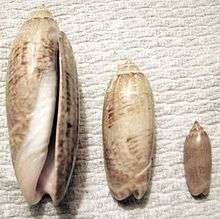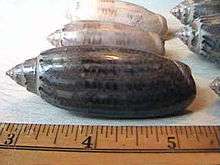Olive snail
| Olive Snail | |
|---|---|
 | |
| Shells of Lettered olive, Oliva sayana | |
| Scientific classification | |
| Kingdom: | Animalia |
| Phylum: | Mollusca |
| Class: | Gastropoda |
| (unranked): | clade Caenogastropoda clade Hypsogastropoda clade Neogastropoda |
| Superfamily: | Olivoidea |
| Family: | Olividae Latreille, 1825 |
| Genera | |
|
See text | |
| Synonyms | |
|
Olivancillariidae | |
Olive snails, also known as olive shells and olives, scientific name Olividae, are a taxonomic family of medium to large predatory sea snails with smooth, shiny, elongated oval-shaped shells. [1]
The shells often show various muted but attractive colors, and may be patterned also. They are marine gastropod molluscs in the family Olividae within the main clade Neogastropoda.
Also see the Olivellidae, the dwarf olives, which were previously grouped within this family, but which now have their own family.
Taxonomy
According to the taxonomy of the Gastropoda by Bouchet & Rocroi (2005) the family Olividae consists of three subfamilies:
- Olivinae Latreille, 1825 - synonyms: Dactylidae H. Adams & A. Adams, 1853 (inv.); Agaroniinae Olsson, 1956; Olivancillariidae Golikov & Starobogatov, 1975
- Ancillariinae Swainson, 1840 - synonym: Ancillinae H. Adams & A. Adams, 1853
- † Vanpalmeriinae Adegoke, 1970
Distribution
Olive snails are found worldwide, in subtropical and tropical seas and oceans.
Habitat
These snails are found on sandy substrates intertidally and subtidally.
Life habits
The olive snails are all carnivorous sand-burrowers. They feed mostly on bivalves and carrion and are known as some of the fastest burrowers among snails. They secrete a mucus similar to that of the Muricidae, from which a purple dye can be made.
Shell description
Physically the shells are oval and cylindrical in shape. They have a well-developed stepped spire. Olive shells have a siphonal notch at the posterior end of the long narrow aperture. The siphon of the living animal protrudes from the siphon notch.
The shell surface is extremely glossy because in life the mantle almost always covers the shell.[2][3]
The fossil record
Olive shells first appeared during the Campanian.[4]
Human use
Olive shells are popular with shell collectors, and are also often made into jewelry and other decorative items.
The shell of the lettered olive, Oliva sayana, is the state shell of South Carolina in the United States.
Genera
Genera within the family Olividae include:
- Agaronia Gray, 1839
- Amalda H. Adams & A. Adams, 1853
- Ancilla Lamarck, 1799
- Ancillina Bellardi, 1882
- Ancillista Iredale, 1936
- Anolacia Gray, 1857
- Baryspira
- Belloliva Peile, 1922
- Calyptoliva Kantor & Bouchet, 2007
- Chilotygma H. Adams & A. Adams, 1853
- Cupidoliva Iredale, 1924
- Eburna Lamarck, 1801
- Entomoliva Bouchet & Kilburn, 1991
- Janoliva Sterba & Lorenz, 2005
- Jaspidella Olsson, 1956
- † Lamprodomina Marwick, 1931
- Oliva Bruguière, 1789
- Olivancillaria d'Orbigny, 1840
- † Spirancilla H. E. Vokes, 1936
- Turrancilla Martens, 1903
- Uzamakiella Habe, 1958
- Genera brought into synonymy
- Ancillaria Lamarck, 1811: synonym of Ancilla Lamarck, 1799
- Subfamily Ancillinae: synonym of Ancillariinae (alternate representation of Olividae)
- Amalda (Gracilispira) Olson, 1956: alternate representation of Amalda H. Adams & A. Adams, 1853
- Ancillus Montfort, 1810: synonym of Ancilla Lamarck, 1799
- Gracilancilla Thiele, 1925: synonym of Ancillina Bellardi, 1882
- Hiatula Swainson, 1831: synonym of Agaronia Gray, 1839
- Lintricula H. Adams & A. Adams, 1853: synonym of Olivancillaria d'Orbigny, 1840
- Porphyria Röding, 1798 : synonym of Oliva Bruguière, 1789
- Scaphula Swainson, 1840: synonym of Olivancillaria d'Orbigny, 1840

See also
- Olivella This genus has now been moved to the Olivellidae according to the taxonomy of Bouchet & Rocroi.
References
- ↑ Bouchet, P.; Gofas, S. (2012). Olividae. Accessed through: World Register of Marine Species at http://www.marinespecies.org/aphia.php?p=taxdetails&id=23082 on 2012-06-11
- ↑ Washington State University Tri-Cities Natural History Museum (2001). Family: Olividae (Olive Shells). Retrieved on 12 July 2006.
- ↑ Vermeij, Geerat J (3 April 1995). A Natural History of Shells. Princeton University Press. ISBN 0-691-00167-7. pps. 89, 100, 114.
- ↑ Vermeij, Geerat J (1 September 1993). Evolution and Escalation. Princeton University Press. ISBN 0-691-00080-8. p.182.
Further reading
- Hunon Ch., Hoarau A. & Robin A. (2009). Olividae (Mollusca, Gastropoda).
External links
| Wikimedia Commons has media related to Olividae. |